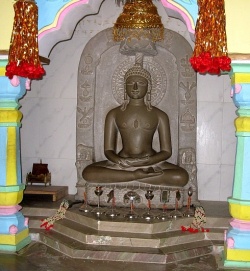Caitika
The Caitika (Sanskrit; traditional Chinese: 制多部; pinyin: Zhìduō Bù) was an early Buddhist school, and was a sub-sect of the Mahāsāṃghika school. They were also known as the Caityaka sect. The Caitikas proliferated throughout the mountains of southern India, from which they derived their name. In Pali writings, members of this sect and its offshoots were generally referred to as the Andhakas, meaning those of the Āndhra region.
History
The Caitikas branched off from the main Mahāsāṃghika school in the 1st or 2nd century BCE. Epigraphic evidence of the Mahāsāṃghikas in the Mathura region dates to the first century BCE, and the Śāriputraparipṛcchā Sūtra dates the formation of the Caitikas to 300 years after the Buddha. The Caitikas gave rise to the Aparaśailas and Uttaraśailas (also called Pūrvaśailas). Together, they comprised an important part of the Mahāsāṃghika located in southern India.[4] Two other sub-sects associated with the Caitikas include the Rājagirikas and the Siddhārthikas, both of which emerged from the Āndhra region, around 300 CE.[5] The Caitikas are said to have had in their possession the Great Stūpa at Sāñchī. The Great Stūpa was first commissioned by Aśoka the Great in the 3rd century BCE, and became known as a Buddhist pilgrimage site. In the Ajaṇṭā Caves, the only epigraphic reference to an early Buddhist sect is to that of the Caitikas, which is associated with an iconic image in Cave 10. The Mahāsāṃghikas were generally associated with the early veneration of anthropomorphic Buddha images. When Xuanzang visited Dhānyakaṭaka, he wrote that the monks of this region were Mahāsāṃghikas, and mentions the Pūrvaśailas specifically. Near Dhānyakaṭaka, he met two Mahāsāṃghika bhikṣus and studied Mahāsāṃghika abhidharma with them for several months, during which time they also studied various Mahāyāna śāstras together under Xuanzang's direction.
Doctrine
The southern Mahāsāṃghika schools such as the Caitikas advocated the ideal of the bodhisattva(bodhisattvayāna) over that of the arhat (śrāvakayāna), and they viewed arhats as being fallible and still subject to ignorance. The main Caitika school, along with the Aparaśailas and Uttaraśailas, all emphasized the transcendental and supernatural character of the Buddha. Xuanzang considered the Mahāsāṃghika doctrine of a mūlavijñāna ("root consciousness") to be essentially the same as the Yogācāra doctrine of the ālāyavijñāna ("store consciousness"). He also noted that the doctrine of the mūlavijñāna was contained in the āgamas of the Mahāsāṃghikas.
Relationship to Mahāyāna
Associations
A.K. Warder holds that the Mahāyāna "almost certainly" first developed from the southern Mahāsāṃghika schools of the Āndhra region, among monastic communities associated with the Caitikas and their sub-sects.
Prajñāpāramitā
A number of scholars have proposed that the Mahāyāna Prajñāpāramitā teachings were first developed by the Caitika subsect of the Mahāsāṃghikas. They believe that the Aṣṭasāhasrikā Prajñāpāramitā Sūtra originated amongst the southern Mahāsāṃghika schools of the Āndhra region, along the Kṛṣṇa River. These Mahāsāṃghikas had two famous monasteries near the Amarāvati and the Dhānyakaṭaka, which gave their names to the schools of the Pūrvaśailas and the Aparaśailas. Each of these schools had a copy of the Aṣṭasāhasrikā Prajñāpāramitā Sūtra in Prakrit. Guang Xing also assesses the view of the Buddha given in the Aṣṭasāhasrikā Prajñāpāramitā Sūtra as being that of the Mahāsāṃghikas. Edward Conze estimates that this sūtra originated around 100 BCE.
Tathāgatagarbha
Brian Edward Brown, a specialist in Tathāgatagarbha doctrines, writes that it has been determined that the composition of the Śrīmālādevī Siṃhanāda Sūtra occurred during the Īkṣvāku Dynasty in the 3rd century CE, as a product of the Mahāsāṃghikas of the Āndhra region (i.e. the Caitika schools). Wayman has outlined eleven points of complete agreement between the Mahāsāṃghikas and the Śrīmālā, along with four major arguments for this association. After its composition, this text became the primary scriptural advocate in India for the universal potentiality of Buddhahood. Anthony Barber also associates the earlier development of the Tathāgatagarbha Sūtra with the Mahāsāṃghikas, and concludes that the Mahāsāṃghikas of the Āndhra region were responsible for the inception of the Tathāgatagarbha doctrine.
Bodhisattva canons
In the 6th century CE, Bhāvaviveka speaks of the Siddhārthikas using a Vidyādhāra Piṭaka, and the Aparaśailas and Uttaraśailas (Pūrvaśailas) both using a Bodhisattva Piṭaka, implying collections of Mahāyāna texts within these Caitika schools. During the same period, Avalokitavrata speaks of the Mahāsāṃghikas using a "Great Āgama Piṭaka", which is then associated with Mahāyāna sūtras such as the Prajñāparamitā and the Daśabhūmika Sūtra. Avalokitavrata also states that Mahāyāna sūtras such as the Prajñāparamitā were recited by the Aparaśailas and the Pūrvaśailas. According to the Theravādin Nikāyasaṅgraha, the large Mahāyāna collection called the Mahāratnakūṭa Sūtra (Taishō Tripiṭaka 310) was composed by the "Andhakas", meaning the Caitika schools of the Āndhra region. This collection includes the Śrīmālādevī Siṃhanāda Sūtra, the Longer Sukhāvatīvyūha Sutra, the Akṣobhyavyūha Sūtra, a long text called the Bodhisattva Piṭaka, and others. The Mahāratnakūṭa collection totals 49 Mahāyāna sūtras, divided into 120 fascicles in the Chinese translation.
Disputes with Theravāda
Textual authenticity
In the Mahāvihara tradition of the Theravāda school, Buddhaghoṣa grouped the Caitika schools in the Āndhra region, such as the Rājagirikas and the Siddhārthikas, as the "Andhakas".[32] These Caitika schools rejected the post-Ashokan texts that were in use by the Mahāvihara tradition, such as the Parivara, the six books of Abhidharma, the Patisambhida, the Niddesa, some Jātakas, some verses, and so on. Works such as the Kathāvatthu show that Mahāvihara polemics were directed overwhelmingly at these "Andhakas" in India.
Interpretation of Buddhist texts
One dispute recorded in the Kathāvatthu between the Mahāviharavasins and the Andhakas was a fundamental matter concerning the interpretation of the Buddha's teachings. The Andhakas are said to have held that the Buddha's actions and speech were supramundane, but some may only perceive the conventional or mundane interpretation. For the Mahāsāṃghika branch of Buddhism, the ultimate meaning of the Buddha's teachings was "beyond words", and words were merely a conventional exposition of the Dharma. The Theravāda Mahāviharavasins, in contrast, argued that literal interpretations of the Buddha's teachings were best.
